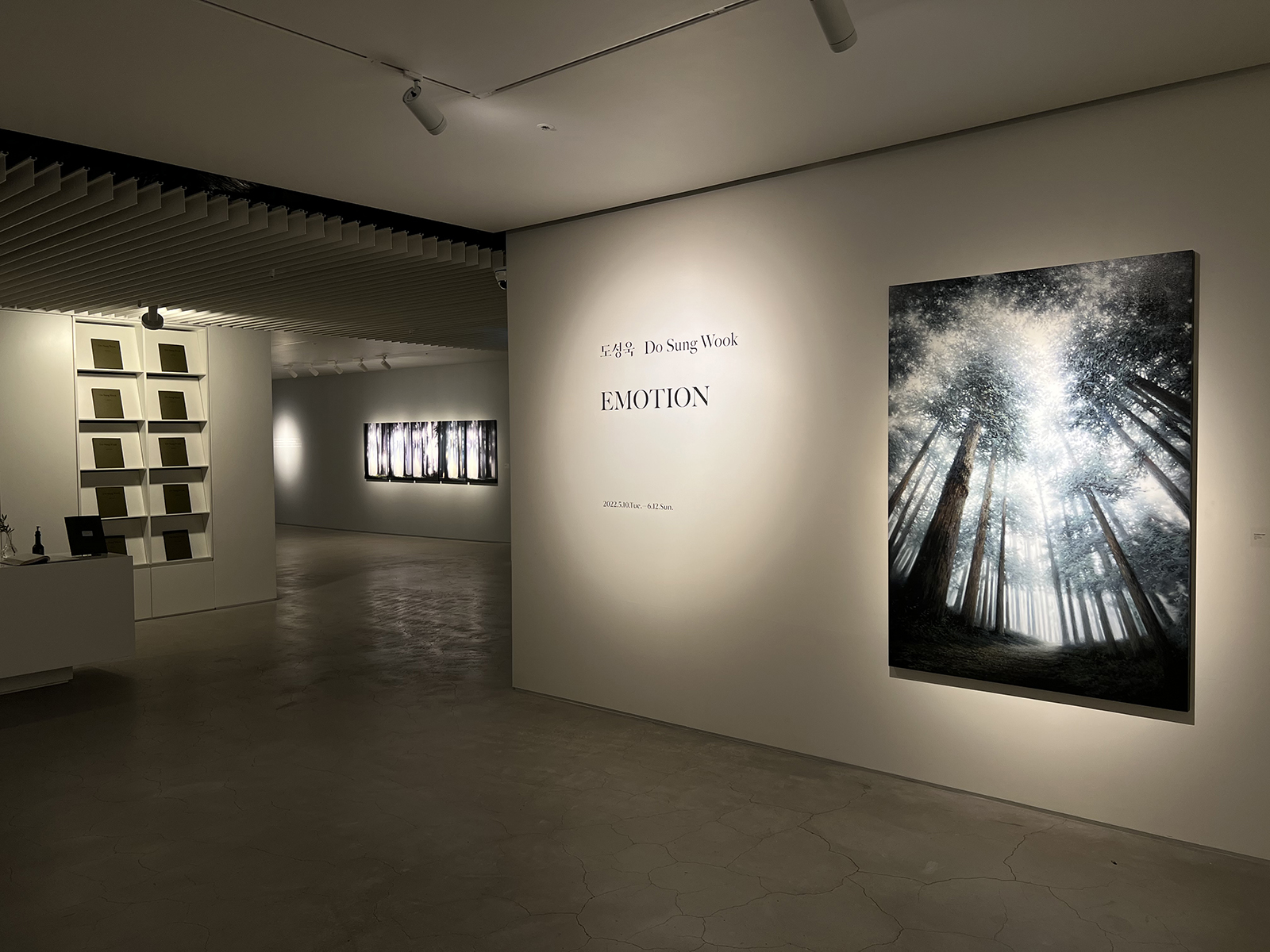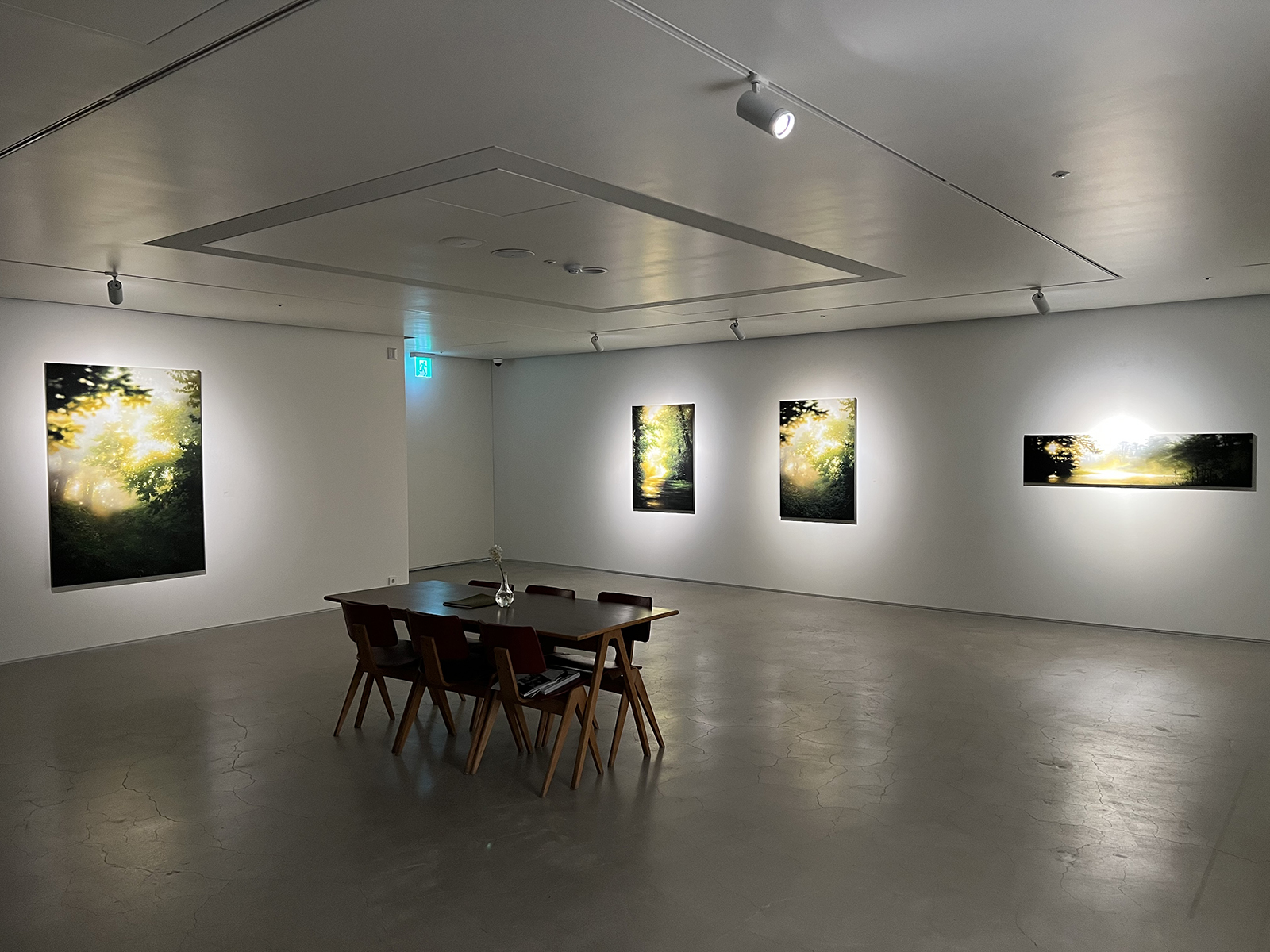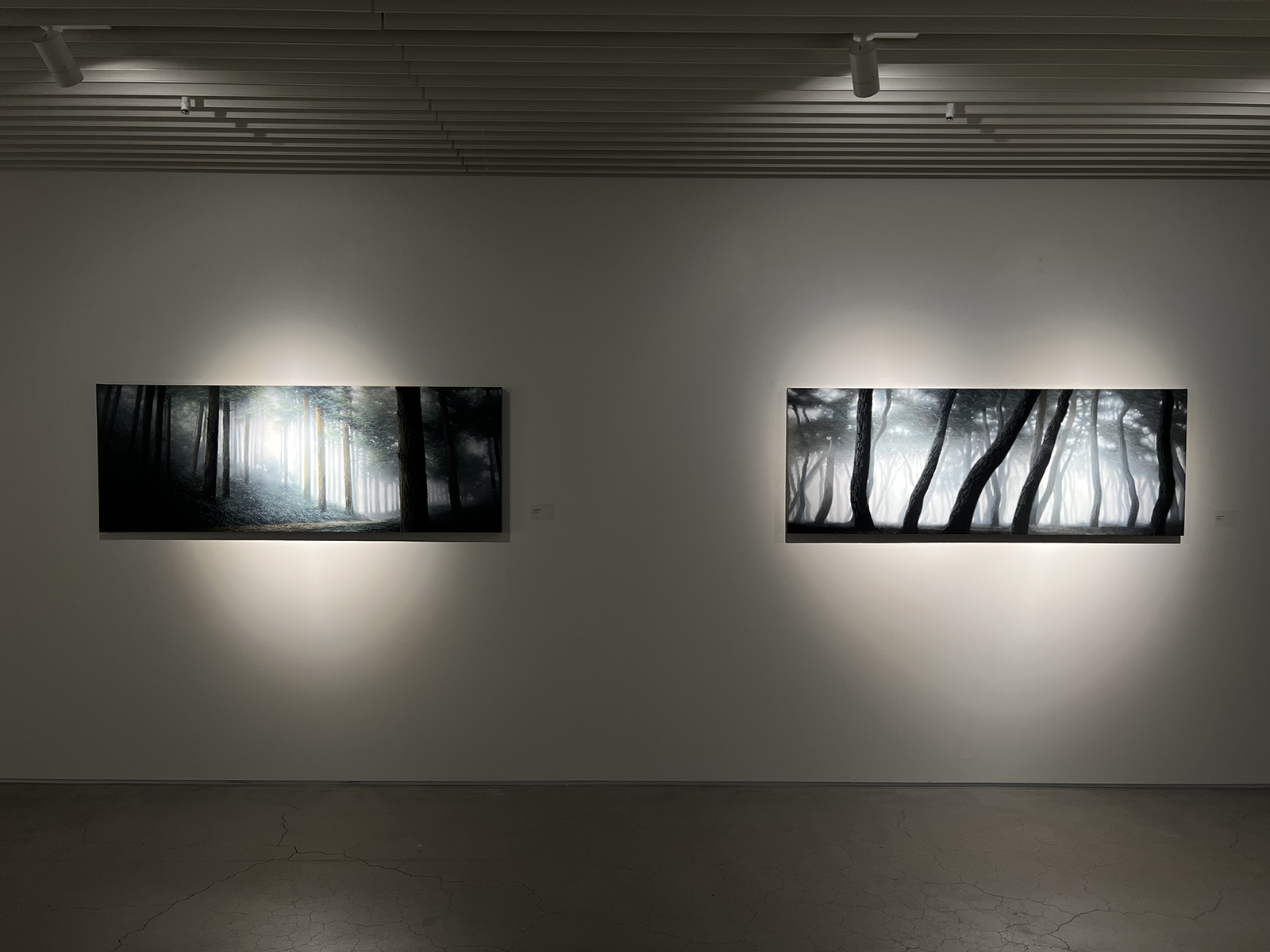EMOTION
Do sungwook2005년 「도성욱 개인전-The Shining Dark」을 계기로 맺은 아티스트와 큐레이터로서 첫 인연 이후 각자 자신의 삶을 그럭저럭 잘 꾸려가고 있음을 알았기에 무소식은 서운함 보다 안녕의 희소식이었다. 하지만 불현듯 전해져 온 사고 소식, 이후 꽤 오랫동안 뜸했던 화가 도성욱이 10여 년 만에 개인전을 개최한다는 소식을 전해왔다. 지천으로 깔린 봄기운을 밟고 나선 길, 그가 보여준 풍경이 그러하듯 익숙하지만 낯선 혹은 낯설지만 익숙한 만남, 16년 만의 재회였다.
No Art, No Life!
모두가 궁금해하지만 선뜻 묻지 못하는 그의 근황을 한 줄로 정리하자면 ‘도성욱은 안녕하다’. 한때 미술시장에서 무척이나 사랑받는 화가로 한 시절을 제대로 풍미했던 그에게 찾아 든 불운한 사고, 하반신 마비라는 심각한 후유증, 그리고 다시 회복된 예술가로서의 일상. 그는 안녕하다.
그림 그리는 화가에게 몸은 기본적인 도구이다. 어찌 보면 캔버스, 붓, 물감보다 더 귀한 무기이다. 건강한 에너지가 충만한 자신의 몸이 온전히 제 것일 때 작가는 그리고 싶은 것을 마음대로 언제든지 거침없이 쏟아낼 수 있다. 안타깝게도 사고 후 그는 자유자재로 쓸 수 있는 건강한 신체라는 기본 도구를 잃게 되었다. 더 이상 손가락으로 붓을 잡을 수도, 허리를 곧추 세워 걸을 수도 없다. 몇 날 며칠 거뜬히 밤을 지새우던 강철 체력도 사라졌다. 하지만 그림이 그리고 싶었다고 한다. 화가가 작업을 할 수 없다면 삶은 과연 어떤 의미일까.
어린 아이가 걷는 법을 배우듯 달라진 몸의 변화와 한계를 인정하고 현재의 신체 조건으로 그릴 수 있는 방법을 찾아 익히기 시작했다. 운동신경은 사라지고 감각신경만 남은 손가락을 대신해 트레이닝 장갑을 끼고, 그 사이에 붓을 끼워 장착한 후 손목으로 그리는 법을 연마했다. 붓 끝이 흔들리지 않도록 손목과 팔의 힘을 기르고, 4박 5일동안 꼬박 휠체어에서 버틸 수 있을 만큼 체력도 키웠다. 또한 어지간한 심리적 혼란에도 쉬이 무너지지 않도록 마음 근육도 단단하게 단련했다. 그에게 강한 몸과 마음은 사고 전으로 회복하는 것이 아니라 현재의 상태를 최선의 모습으로 유지하는 것이다. 여전히 고통스럽고 불편하지만 마침내 작품 제작의 기본 도구인 몸을 제대로 사용하는 단계에 도달했다. 게다가 직접 고안한 전동식 캔버스 틀을 설치하면서 대형 작품도 거뜬히 제작할 수 있는 작업 환경이 갖춰졌고 다시 그림 그리기에 집중하고 있다. 처음 만났던 그 때 그 시절부터 지금까지, 도성욱은 여전히 성실하게 창작자의 삶 속에 있다.
No art, No Life!!, ‘그저 그림을 그리고 싶다’는 예술가로서의 생에 의지는 감히 가늠조차 불가한 절망과 좌절, 아픔을 견디게 해준 유일한 삶의 동기이자 에너지의 원천이었다. 오늘의 자신에게 주어진 신체적 조건을 토대로 그림 그리는 법을 제대로 익혔으니 다음 단계는 표현 능력을 예전 수준으로 끌어올리는 것이 관건이었다. 현재의 상태를 파악하기 위한 기준점은 바로 어제의 도성욱이었다. 많은 이들에게 큰 울림을 주었던 이전 작품 이미지를 차용해서 자기를 복제하기 시작했다. 무디어진 눈과 손의 감각을 되살리기 위해 숱한 자기 복제의 시간을 지내고 나서야 스스로 부끄럽지 않을 정도의 묘사력이 회복되었다. 처절한 자기 모방은 결국 자기 변화의 길을 열어주었다.
새로운 풍경들
대표작 <Condition-light> 시리즈에서 헤아릴 수 있듯 회화의 조건이자 궁극적 지향점은 ‘빛의 묘사와 표현’이다. 작가는 “빛이란 비물질화된 형상이다. 그 자체로 구상에서 보이는 사물의 형상 재현이라는 틀이 없다. 형태가 없으니 의도하는 대로 구성이 가능하고 또 그 빛과 접촉하는 모든 물질을 비물질화시키는 효과를 갖는다”고 언급한다. 도성욱의 풍경은 아주 단순하다. 빛과 나무숲, 그리고 길. 누구나 한 번쯤 보았을 법한 숲, 나뭇잎 사이로 흩어지는 빛의 파편들, 숲속 어딘가로 끝없이 이어진 길이 있다. 혹자는 그의 풍경을 비물질적 조건을 중심으로 풀어낸 일종의 판타지라고, 또 다른 이는 이상향에 대한 작가의 비전이 만들어낸 순수한 가공의 풍경이라고 한다. 어쨌든 눈앞에 현존하는 자연 속 풍경과 너무 닮은 탓에 누구나 어디서 본 것 같은 데자뷔를 경험하지만 실상 상상력이 만들어낸 실재하지 않는 풍경일 뿐이다.
새롭게 선보일<Emotion-light> 시리즈에 대해 작가는 “형이상학적 존재들을 모아 직관적인 시각으로 채운 화면, 이 하나의 조건이 다수에 의해 굴절된 감성으로 내면에 담기면서 완성이 된다”고 설명한다. 굳이 두 개 시리즈의 차이를 찾아본다면 일단 빛과 공기, 온도, 습도 등 비물질적 요소를 묘사하기 위해 숲과 바다가 여전히 배경으로 등장한다. 하지만 <Condition-light> 작품이 길을 중심으로 빛이 깃든 숲의 전경을 다룬 풍경이라면 <Emotion-light>는 전체 화면 중 세부만 부분 확대하여 전면적으로 배치한다는 점이 다르다. 또한 전작이 초록색 위주의 모노톤 화면에 선명하게 쏟아지는 백색 광선이 지배적이었던 것에 반해 후작에서는 빛의 색과 온도가 달라졌다. 안갯속 쨍한 백색 광선이 황색, 자색, 남색 등 가시광선의 다채로운 색의 스펙트럼으로 대체되면서 한결 부드럽고 따뜻한 온도를 품는다. 또한 <Emotion-light> 작품들은 추상적 면모가 더욱 강화되었다. 화폭에 등장하는 빛은 산란하는 파편이 아닌 덩어리로 모습을 드러낸다. 하늘을 배경으로 삼은 커다란 잎사귀의 틈 혹은 우뚝 서있는 나무줄기 사이를 파고드는 빛의 형체는 가느다랗게 실눈으로 본 광경이다. 꼼꼼하게 채우듯 묘사하는 대신 과감하게 지워내고 뭉개면서 빛은 색을 품고 작가의 내적 표현으로 완결된다.
화면 구성과 색채 사용에서, 숲의 전체 혹은 세부, 백색이거나 다색의 빛 등 차이도 있지만 동일한 특징도 감지된다. 대다수 구상적 경향의 회화가 극도의 섬세한 붓 터치로 사물이나 대상의 재현적 묘사에 집중하는 반면 작가의 묘사는 다르다. 언뜻 사실적 묘사로 착각하기 쉽지만 잠시라도 화면을 뚫어지게 들여다본 사람은 안다. 결코 사실적이지 않다는 것을, 심지어 추상적이다는 것을 발견한다. 근경에서 원경까지 최소 7~8겹의 레이어가 겹치는 동안 나뭇잎, 나무, 흙 길, 돌멩이 등 숲속 대상물을 세세하고 치밀하게 재현하기보다는 우선 넓은 색면으로 기본적 형태를 구축한다. 그리고 절제된 붓질로 대상의 본래적 특성을 제대로 짚어낸다. 무척 쉬워 보이지만 사물의 본질을 제대로 파악하는 날카로운 눈을 가진 작가만이 행할 수 있는 표현 기법이다.
과거 어두운 숲과 밝은 빛이라는 극적 대비를 대신해서 빛은 공기처럼 숲 전체를 부유한다. 나무와 길, 하늘, 무엇 하나 도드라지는 것 없이 부드럽게 하나로 스며든다. 금방이라도 안개를 걷어내고 맑은 하늘이 튀어나올 거 같던 광선은 여기저기 흩어지는 안개를 따라 느릿느릿 숲을 에워싼다. 모든 존재들의 아우성이 잦아들고 시간이 멈춘 듯 고요하다.
하나 덜의 비움
리마인드 전시라고 스스로 명명한 이번 전시는 예술가 도성욱의 처음과 현재 그리고 다음을 가늠할 수 있는 기회이다. 그의 삶은 사고 전과 후로 달라질 수밖에 없었다. 자신만의 고유한 화법을 발견하는 데 있어 이전 작업의 출발점이 ‘무엇을 더한다’였다면 지금은 ‘무엇을 덜어낸다’가 되었다. 과거의 그는 어제 그린 작품보다 오늘 더 잘 그려야 하고, 사람들이 원하고 기대하는 것보다 더 많이 해내기 위해 더하고 보태는 작업을 했다. 도성욱 풍경화의 절대 조건이었던 빛 자체의 극적인 묘사와 표현을 위해 ‘하나 더의 채움’에 몰두하였다. 그러나 빛이 더 이상 단순히 눈에 보이는 광선이 아닌 작가의 내적 감성이 투영된 무드가 되기 위해 ‘하나 덜의 비움’을 선택했다. 명암의 극적 대비를 위한 장치들 즉 파편화된 빛의 조각, 줄기와 잎사귀를 채우던 붓질, 여러 겹으로 중첩되는 화면 등을 하나둘씩 덜어내고 비워 내었다. 상상 속 숲은 더 이상 고결한 기운이 감도는 성소가 아니다. 울고 웃고, 슬프고 즐거운 인간적 감정과 감성을 기꺼이 수용하는 살아있는 숲이 되었다. 오랜만의 만남, ‘자유’라는 단어가 자꾸자꾸 들린다. 자유롭지 못한 그가 ‘하나 덜의 비움’으로 더 큰 자유를 찾을 요량인가 보다.
누구를 위해 그리는가. 어떻게 그리는가. 그리고 왜 계속 그리는가. 묻고 또 물었을 것이다. 과연 그가 얻은 답은 무엇일까. 작품이 자신이 아닌 타인으로 향하며 3인칭 시점으로 변화하는 순간 볼거리, 느낄 거리, 이야깃거리는 분명 풍성해지겠지만 자기가 사라진다. 그는 자신의 시선과 감성을 작품의 주인공으로 재설정하고 1인칭 시점의 본인 이야기를 펼쳐내고 있다.
도성욱의 풍경은 이전에도 그랬고 지금도 그러하다. 어디선가 본 것 같지만 어디에도 존재하지 않는 풍경. 그런 풍경을 만든 것은 작가이지만, 어느 순간 그의 손을 떠나 자립적으로 움직여야 비로소 참된 의미에서 살아있는 풍경이 된다. 그의 풍경이 우리의 풍경이 되는 순간이 화가가 꿈꾸는 자유일지 모르겠다.
무라카미 하루키는 말한다. “소설가란 예술가이기 이전에 자유인이어야 합니다. 내가 좋아하는 것을 내가 좋아하는 때에 나 좋을 대로 하는 것, 그것이 나에게는 자유인의 정의입니다. 예술가가 되어서 세간의 시선을 의식하거나 부자유한 격식을 차리는 것보다 극히 평범한, 근처를 어슬렁거리는 자유인이면 됩니다.”
김윤희(포스코미술관관장, 경영학박사)
No news was good news of well-being rather than disappointment because they knew that they were doing well in their lives since their first relationship as artists and curators signed in the 2005 Do Sung-wook Individual Exhibition – The Shining Dark. However, the news of the accident that has suddenly been reported, and the artist Do Sung-wook, who has been rare for quite a while, has been holding an individual exhibition for the first time in more than a decade. It was the first reunion in 16 years, a familiar, unfamiliar, but unfamiliar encounter, as he showed the scenery of spring.
No Art, No Life!
To summarize his recent situation, which everyone is curious about but cannot ask, “Do Sung-wook is well-being.” The unfortunate accident that he found when he was a very beloved painter in the art market, the serious aftereffects of paraplegia, and his daily life as a recovered artist. He is well.
The body is a basic tool for a painter. In a way, it’s a more precious weapon than canvas, brush, and paint. When his body full of healthy energy is completely mine, the writer can pour out whatever he wants to draw at any time. Unfortunately, after the accident, he lost the basic tool of a healthy body that he could use freely. You can no longer hold a brush with your fingers or walk upright. Steel stamina, which had been staying up for days and days easily, has also disappeared. But he wanted to draw a picture. What does life mean if an artist can’t work?
Just as a young child learns to walk, he recognized the changes and limitations of his body and began to find and learn how to draw under the current physical conditions. Instead of fingers with only sensory nerves left, he wore training gloves, inserted a brush between them, and honed how to draw with his wrist. He developed the strength of his wrist and arm to prevent the tip of the brush from shaking, and he also improved his physical strength enough to endure in a wheelchair for four nights and five days. In addition, the mental muscles have been strengthened so that they do not easily collapse despite considerable psychological confusion. A strong body and mind for him is not to recover before the accident, but to keep his current condition in its best shape. Although it is still painful and uncomfortable, it has finally reached the stage of properly using the body, the basic tool of production. In addition, while installing a self-designed electric canvas frame, it has a working environment where large works can be easily produced, and it is focusing on painting again. From the time we first met until now, Do Sung-wook is still faithfully in the life of the creator.
No art, No Life!!, Will as an artist who just wants to paint was the only motivation and source of energy that allowed me to endure despair, frustration, and pain that I dare not measure. Since I learned how to draw properly based on the physical conditions given to me today, the next step was to raise my expression skills to the previous level. The reference point for grasping the current state was yesterday’s Do Sung-wook. He began to duplicate himself by borrowing images of his previous work, which made a great impression on many people. It was only after spending a lot of time replicating oneself to revive the dull eyes and the sense of hands that he was not ashamed of himself. Desperate self-imitation eventually paved the way for self-change.
new landscapes
As can be counted in the representative work “Condition-light” series, the condition and ultimate goal of painting is ‘description and expression of light’. The author said, “Light is a non-materialized figure. In itself, there is no framework for reproducing the shape of objects seen in the concept. Since there is no shape, it can be constructed as intended and has the effect of dematerializing all materials in contact with the light. The scenery of Do Sung-wook is very simple. Light, tree forest, and road. There is a forest that anyone may have seen at least once, fragments of light scattered through the leaves, and an endless path somewhere in the forest. Some say it is a kind of fantasy that unravels his landscape around non-material conditions, and others say it is a pure fictional landscape created by the artist’s vision of utopia. In any case, everyone experiences a deja vu as if they have seen it somewhere because it resembles the existing natural scenery in front of them, but it is actually just a non-real landscape created by imagination.
Regarding the new <Emotion-light> series, the author explains, “The screen that collects metaphysical beings and fills them with an intuitive perspective, and this one condition is completed by being embedded inside with emotions refracted by the majority.” If you look for the difference between the two series, forests and the sea still appear in the background to describe non-material factors such as light, air, temperature, and humidity. However, if the work of “Condition-light” deals with a panoramic view of the forest with light centered on the road, “Emotion-light” is different in that only details of the entire screen are enlarged and arranged. In addition, while the previous work dominated the green-oriented monotone screen with clear white rays, the color and temperature of the light changed in the latter part. The bright white light in the fog is replaced by a colorful spectrum of visible light such as yellow, purple, and navy, and has a softer and warmer temperature. In addition, the abstract aspects of <Emotion-light> works have been further strengthened. The light appearing on the canvas appears as a mass, not as a scattered fragment. The shape of light penetrating between large cracks in leaves set in the sky or towering tree trunks is a scene seen with thin eyes. Instead of describing it as if it were meticulously filled, it boldly erased and crushed, and the light is completed with the artist’s inner expression with color.
In screen composition and color use, the same characteristics are also detected, although there are differences such as the whole or detail of the forest, white or multicolored light. While most of the paintings with conceptual tendencies focus on the reproduction of objects or objects with extremely delicate brush touches, the artist’s description is different. At first glance, it is easy to mistake it for a realistic description, but those who have stared at the screen for a moment know. I find it never realistic, even abstract. While at least seven to eight layers overlap from near to far, rather than reproducing forest objects such as leaves, trees, dirt roads, and stones in detail, it first builds a basic shape with a wide color surface. And the original characteristics of the object are properly identified with an understated brushstrokes. It seems very easy, but it is an expression technique that can only be performed by a sharp-eyed artist who properly understands the nature of things.
In place of the dramatic contrast between dark forests and bright lights in the past, light floats the entire forest like air. Trees, roads, sky, nothing stands out, and it gently seeps into one. The rays, which seemed to remove the fog and a clear sky, slowly surround the forest along the scattered fog. The roar of all beings has died down and time has stopped.
one less emptying
The exhibition, named Remind Exhibition, is an opportunity to gauge artist Do Sung-wook’s first, present and next. His life was bound to change before and after the accident. If the starting point of the previous work in discovering one’s own unique way of speaking was ‘add something’, it is now ‘take something out’. In the past, he had to draw better today than he did yesterday, and he added and added more to do more than people wanted and expected. For the dramatic description and expression of the light itself, which was an absolute condition of Do Sung-wook landscape painting, he was immersed in ‘filling one more’. However, he chose “one less emptying” to become a mood in which the light is no longer simply visible light, but the artist’s inner sensibility is projected. Devices for dramatic contrast of light and shade were removed one by one, such as fragmented pieces of light, brush strokes filling stems and leaves, and overlapping screens overlapping in layers. An imaginary forest is no longer a sanctuary with noble energy. It has become a living forest that is willing to cry, laugh, and embrace sad and pleasant human emotions and emotions. It’s been a long time since I’ve met you, the word “freedom” keeps on and on. He, who is not free, must find greater freedom with “one less emptying.”
For whom you draw. How to draw it. And why do you keep drawing. I would have asked and asked. What is the answer he got? As soon as the work is directed to others, not yourself, and changes to a third-person perspective, the things to see, feel, and stories will surely be abundant, but they disappear. He resets his eyes and emotions as the main character of the work and tells his story from a first-person perspective.
The landscape of Do Sung-wook has been and remains the same. A landscape that seems to have been seen somewhere, but does not exist anywhere. It is the artist who created such a landscape, but at some point, it is necessary to leave his hands and move independently to become a living landscape in a true sense. The moment when his landscape becomes our landscape may be the freedom that an artist dreams of.
Haruki Murakami says. “A novelist must be a free man before he is an artist. Doing what I like when I like it, which is the definition of a free man to me. Rather than being an artist and being conscious of the public’s gaze or displaying unnatural formality, you just need to be a free man who roams around.”
-
Do sungwook
Contact



